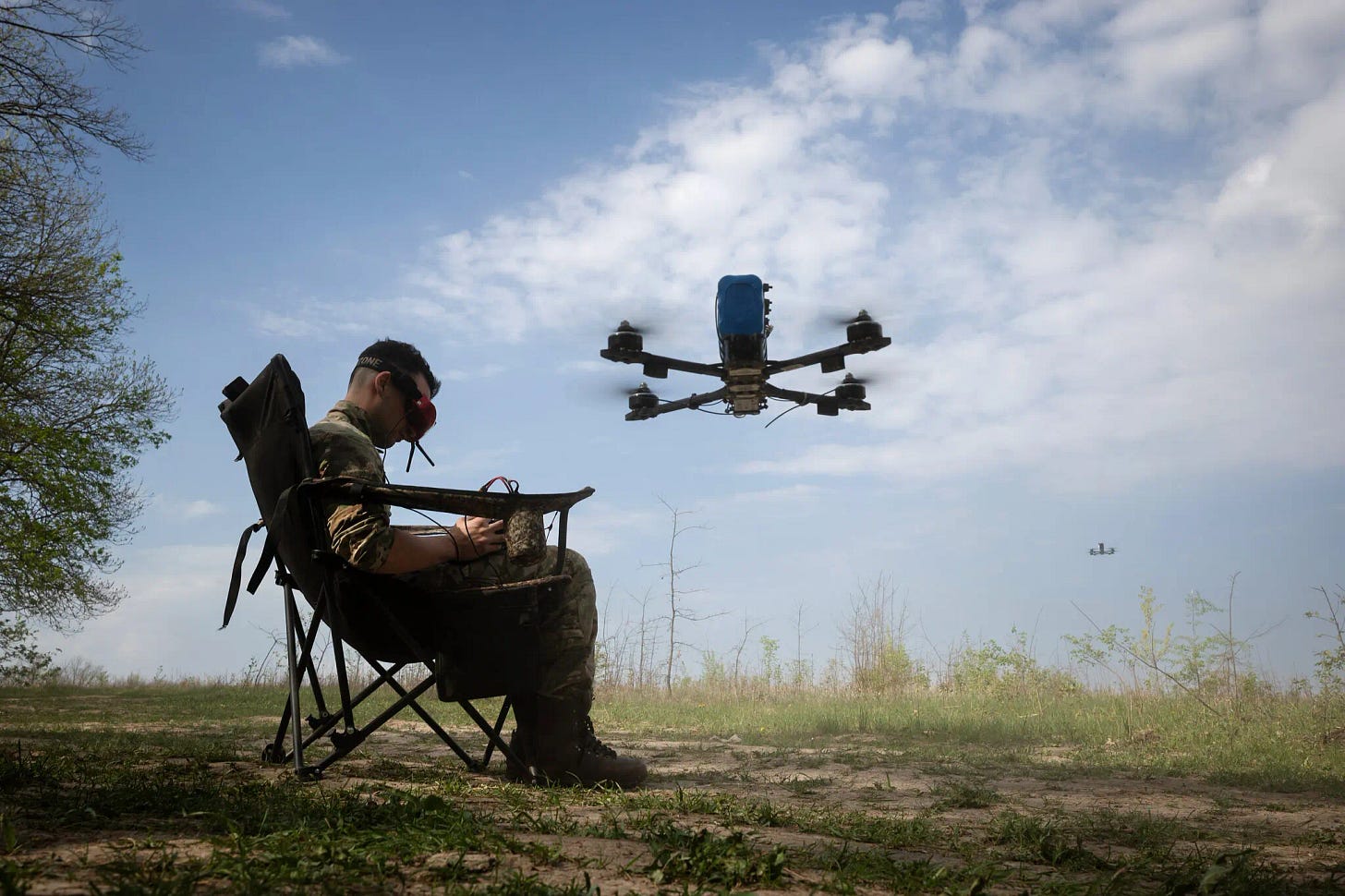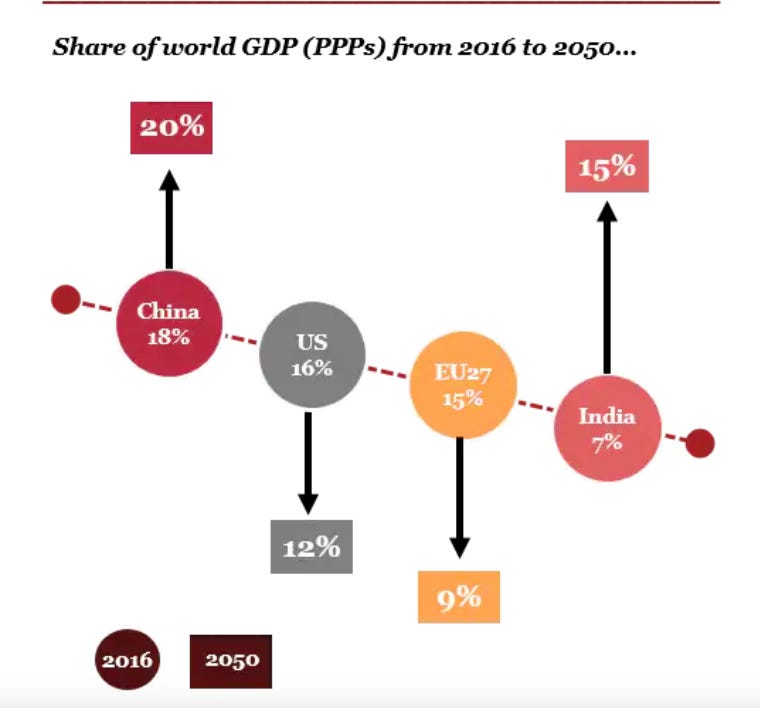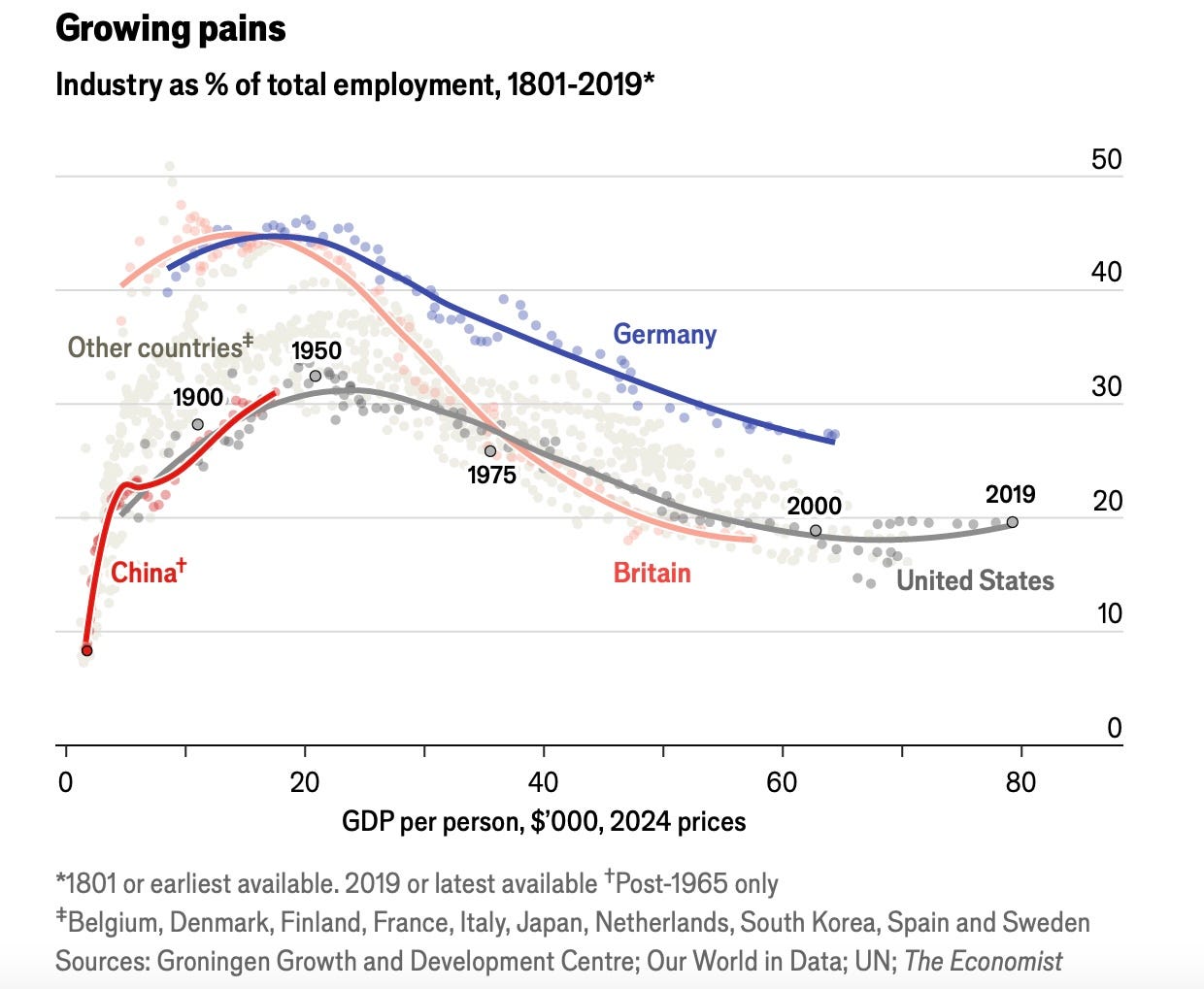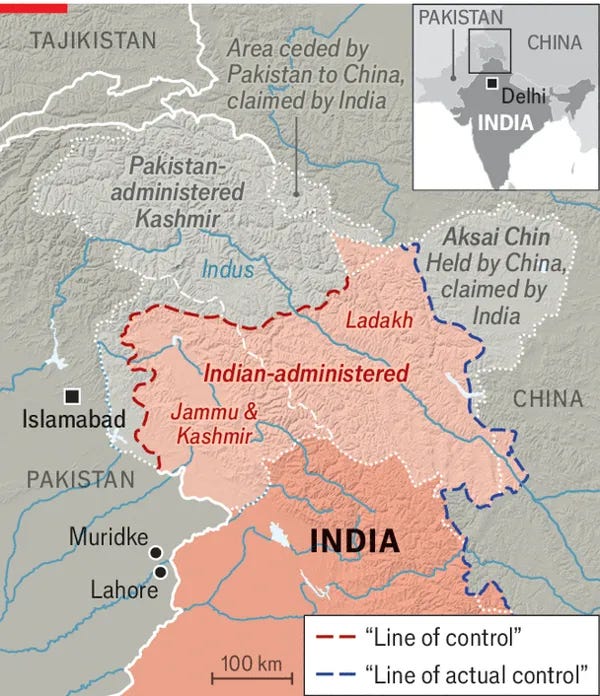This is a reader-supported publication. I give it all away for free but could really use your support if you want me to keep doing this.
1) All the border’s a base, and all the migrants and military merely players
WAPO: First migrants charged with entering restricted military zone at border
NYT: U.S. Creating Second Military Zone Along Southern Border
Talk about mission creep. Now, we have military base creep.
The US Government has created a fake military base along a swath of the US border so that it can charge migrants with trespassing on a military base when they cross the border. In that way, the Trump administration simultaneously bypasses border laws while shifting their processing to military units operating there.
Evil genius, say I, with accent on “evil.”
The Justice Department has begun the first criminal prosecutions of migrants who breach a newly expanded military zone at the southern border that is patrolled by U.S. troops, threatening people with additional penalties for crossing the U.S.-Mexico border illegally.
At least 28 migrants were charged Monday with crossing into the 170-mile-long “National Defense Area,” a 60-foot strip of land that stretches across the bottom of New Mexico and has effectively been turned into part of a U.S. military installation. Prosecutors added the new charge of violating security regulations in U.S. District Court in Las Cruces to the more common misdemeanor of entering the United States illegally.
Both crimes are classified as misdemeanors. But the new charge increases the possible penalties to up to a year in custody and $100,000 in fines, whereas the traditional illegal-entry charge carries only a maximum six-month jail term and up to $5,000 in fines.
Neat trick, huh? A second such zone is being set up in Texas.
Maybe we can just start designating large swaths of America as “military zones” so our forces can get around posse comitatus restrictions and start policing operations within our borders. Why not declare some sanctuary city to be an expanded military zone? So the military can implement crowd-control measures as needed?
Now, we’re getting somewhere on nation-building at home!
The “black helicopter” people must be loving this … you know .. because it’s a right-wing government comforting — not confronting — us with martial law … you know, the good kind.
Sound like a stretch to you? It shouldn’t after this trick. This administration will cross every and any Rubicon and keep rolling until SCOTUS calls them off and they submit … or so we hope.
Military patrolling the streets, masked gunmen snatching people off corners … it’s all good, and perhaps entirely necessary if America (I mean, White America) is going to be saved.
The American Civil Liberties Union of New Mexico said the military’s expanded powers allow service members to “detain civilians, conduct physical searches, implement crowd control measures, and assist with barrier installation” in the New Mexico National Defense Area.
This is all about piling on the criminal charges while militarizing the border.
How this gets us a more “lethal” military, I am unclear.
Maybe if SECDEF dropped and gave the cameras 30!
We’ve already had our first military casualties — two dead in a vehicle rollover when patrolling.
This takes us from policing the world with our military to policing our own territory with our military — America first, alright.
Bring the boys home, bring the war home.
But understand this: when you turn something into a war, war crimes are sure to follow.
2) Insurance as Achilles heel of agriculture re: climate change
JOURNAL OF DATA SCIENCE, STATISTICS, AND VISUALIZATION: Climate-Driven Doubling of U.S. Maize Loss Probability: Interactive Simulation with Neural Network Monte Carlo
From the abstract:
Climate change not only threatens agricultural producers but also strains related public agencies and financial institutions. These important food system actors include government entities tasked with insuring grower livelihoods and supporting response to continued global warming. We examine future risk within the U.S. Corn Belt geographic region for one such crucial institution: the U.S. Federal Crop Insurance Program. Specifically, we predict the impacts of climate-driven crop loss at a policy-salient “risk unit” scale. Built through our presented neural network Monte Carlo method, simulations anticipate both more frequent and more severe losses that would result in a costly doubling in the annual probability of maize Yield Protection insurance claims at mid-century.
A doubling of crop insurance claims in just 25 years.
No specific predictions on how much more expensive those policies become, as a result. The cost of crop insurance in the United States is shared between farmers and federal taxpayers, with the government covering the majority of the expense (60-65%).
Homes in some US regions are too vulnerable to climate change to insure now. How long until farmland becomes too vulnerable to insure?
3) “I didn’t think it would happen in my lifetime.”
PBS FRONTLINE: ‘A Place to Escape To’: Why Some Alaska Native Villages Are Facing Relocation
The perfect clip:
“Our ancestors said one day we will come upon this day,” Agatha Napoleon, who serves as the climate change coordinator for the Native Village of Paimiut, says in the documentary. “I didn’t think it would happen in my lifetime.”
Warming climate eliminates the permafrost conditions. Once that happens, the shoreline crumbles with each wave. With climate change, the storms grow bigger and badder, yielding, as one tribal elder put it: “an entire lifetime’s worth of erosion in one storm.”
Don’t worry. Once the Trump Administration kills PBS, we won’t have to suffer such doom-and-gloom reporting from Frontline.
4) Spread the wealth
VISUAL CAPITALIST: Visualized: Population vs. GDP by Global Region
Fourteen percent of the world’s population (namely, Europe + North America) with 52% of the world’s wealth? You better have a big military alliance alright.
North America is 5% of the world’s population to Latin America’s 8%, but the northern duo possess almost five times the percentage of wealth. With climate change decimating most of Latin America, it’s not hard to guess where climate migrants will be headed.
Turning to the other hemisphere: it’s interesting to see China punching at its weight.
Come mid-century, China and India will, in combination, outweigh Europe + North America in terms of aggregate purchasing power parity. Price Waterhouse has run the numbers:
Soon enough, all of Asia will be punching at its true weight, and the East-West wealth scales will finally be balanced.
5) Meanwhile, Huawei marches on
FOREIGN AFFAIRS: China Is Still Winning the Battle for 5G—and 6G
A few years back I attended a Huawei senior leadership retreat in Morocco as an outside advisor. They struck me as a supremely ambitious lot, right up to their founder.
The idea that the US Government can box them in around the world is a bit fantastic. Huawei is just smart enough and persistent enough to work around almost anything we throw at them.
As this article points out, America blithely ruled 2G, 3G, and 4G, only to see Huawei and China in general muscle in suddenly on 5G, triggering our determined pushback ever since.
A lot of Western firms have fallen by the wayside in the equipment market now dominated by Huawei and just two non-Chinese competitors: Sweden’s Ericsson and Finland’s Nokia. These latter two dominate the US market — by our choice.
Here’s the point I’ve been making for a while:
This is not simply about Western firms’ lost market share. Huawei’s networks carry valuable data, which the company is obliged under Chinese intelligence laws to provide at the government’s request. That access would be valuable to Beijing at any time. But now, in the era of artificial intelligence, the data sets that Huawei transports also have another function: training AI models. Huawei has deployed its Smart City services—which can include street camera imaging; electricity, gas, and water meter data; and social media analysis—in more than 200 cities in 40 countries, from Singapore to Spain. The data sets this produces could be fed straight into Chinese AI models and made available to China’s military and intelligence agencies, making Beijing not just a leader in telecommunications but the dominant player in the use of AI for public safety and national security. The recently exposed Salt Typhoon hacking operation, which targeted major U.S. telecommunications firms, also demonstrated China’s determination to gain access to U.S. networks by any means necessary.
China’s quantum grand strategy means it wants the access to get the big data to grow the AI to solidify network centrality across as much of the world as possible to allow the widest surveillance nets possible — the Minority Report meets the Party Report.
America’s countering strategy is clear:
Washington’s objectives have not changed. It needs to compete with China at scale, narrow the price gap between U.S. and Chinese technologies, and encourage wider adoption of trusted systems. The way to accomplish this is with incentives for technology innovation and joint financing for countries choosing between Chinese and non-Chinese technologies.
This is why I proposed the SysAdmin Force back in the day: the real competition among superpowers is who connects the mostest the fastest and locks those networks into its spheres of influence.
That is a global game. That is the only game.
6) Canaries in the coalmine
GUARDIAN: Collapsing bird numbers in North America prompt fears of ecological crisis – research
Three-quarters of all North American bird populations indicate they are in significant decline.
The truly bad news, per the study leader:
The main ecological finding is that the locations where these species were thriving in the past, where the environments were really well suited to birds, are now the places where they are suffering the most.
The positive news: small pockets where virtually all birds are doing better.
What that tells me is climate shift is driving the stress — as in, adapt, move, or die. When the birds make the right move, they do okay. When they don’t, they decline.
Big lesson for humans, one might say, because, where birds do well, historically people do well — and vice versa.
7) Crypto contamination
NYT: Secret Deals, Foreign Investments, Presidential Policy Changes: The Rise of Trump’s Crypto Firm
Trump 2.0 is in a huge rush to do all sorts of things, with crypto being one of them. But the inter-mixing of personal wealth and policy (self-dealing) carries the potential to taint all this in a profound and lasting manner.
This is just plain dangerous for all involved:
Mr. Trump’s return to the White House has opened lucrative new pathways for him to cash in on his power, whether through his social media company or new overseas real estate deals. But none of the Trump family’s other business endeavors pose conflicts of interest that compare to those that have emerged since the birth of World Liberty.
The firm, largely owned by a Trump family corporate entity, has erased centuries-old presidential norms, eviscerating the boundary between private enterprise and government policy in a manner without precedent in modern American history.
Mr. Trump is now not only a major crypto dealer; he is also the industry’s top policy maker.
Done wrong or just plain sloppy, and this venture has the potential to poison the crypto well for a good long time, especially if it gets partial blame for the recession-in-the-works.
8) The Saharan comes to the Sub-Saharan
MSN: Farmers devastated as key crop becomes nearly impossible to grow: 'Customers are complaining, and my business is suffering'
As a rule, Nigeria has been able to grow food (yam, cassava, cowpeas, sesame, rice). It’s located below the Saharan Desert in the so-called Trans Sahel, where the north’s deserts yield to the rest of the continent’s grasslands and jungle.
Problem is, the Saharan climate is shifting southward in terms of temperature and precipitation, and that is going to stress Nigeria considerably.
Extremely high temperatures are threatening the tomato farming region in Kano, Nigeria. Temperatures are exceeding 95 degrees Fahrenheit when tomatoes need between 59 degrees Fahrenheit and 90 degrees Fahrenheit to comfortably grow.
Farmer Fatima Musa shared her frustration with Business Day Nigeria: "By the time we transport them, half are already bad."
Same story with onions.
There are ways to fight it, like genetically engineering the crops in question to withstand higher heat and expanding and extending the cold-storage chain between farm and fork.
The changing climate is just going to make it harder — nonetheless, meaning it’s just going to cost more to get the same result. And when you do succeed, guess what? Almost all of your machine solutions end up driving farmers off the land anyway.
Socialize the latitudinal risk, say I. Think, North-South integration and North-South optimization as the long-term solutions
9) Romanticizing the past, romanticizing factory work
ECONOMIST: Did international trade really kill American manufacturing?
When you see it laid out like that, you sense the inevitability of it all: industrialization is how you rise, but, once risen, it drops off and you move on up to the service side — losing those factory jobs to “younger” economies (trade being typically cited for about 20% of job loss) and automation (usually cited as to the remaining 80%).
You also get Trump’s obsession with trying to return to 1890s rising America, thus replicating China’s current position on the curve. Except, you can’t go back there, because, given the choice and opportunity, NOBODY wants a factory job and is even less interested in passing one along to their kids.
All this nostalgia for the 1890s and the 1950s is just plain goofy. Workers aren’t going back to the former, and women and minorities aren’t going back to the latter.
There is just no happiness to be pursued in the past.
10) All Quiet on the Virtual Front
NYT: Amid Uncertainty About U.S. Support, Ukraine Pins Its Hopes on Innovation
Ender’s Game has arrived in Ukraine.

In my opinion, it really arrived when a smaller military adopted it in a big way to asymmetrically deal with a far bigger conventional force, so, America’s pioneering use during the Global War on Terror paved the way but this is the fulsome expression of the looming military singularity. Ukraine is chasing this future BECAUSE IT HAS TO.
I had the pleasure to spend a week with the author (Orson Scott Card) at Special Operations Command in Florida back in the day — July of 2004.
Having said that, this cite is strictly about the photo above. Just too revealing on so many levels.
Not exactly 12 O’Clock High.
A battlespace too dangerous for humans. It really is progress.
11) Drones: the spillover expands
DEFENSE NEWS: Pentagon seeks drone-killing technology that’s safe for civilians
Pentagon’s Defense Innovation Unit (DIU) boss stating the obvious:
We must dramatically improve our capacity and speed to update unmanned and counter-unmanned technologies … It’s really about those low-collateral interceptors and getting after those solutions — whether it’s through electronic means, kinetic or ballistic means or other forms of bringing those drones down,
It’s needed by troops at the tactical edge now. It’s needed now by naval forces (see, Houthis). And, ultimately it’ll be needed by police departments seeking to protect civilian populations. These technologies will find use protecting all manner of government buildings and critical infrastructure. They’ll be operating at NFL games. They will become a ubiquitous part of our public lives. Imagine big “safe zones” that are super-sensored with responding drones and counter-drone technologies — with no guns allowed. Ink spots at first, but then rapidly spreading throughout the land.
The future isn’t some Golden Dome with missiles; it’s this type of enforced safe zones with drones.
12) To keep an eye on
ECONOMIST: India and Pakistan are bracing for a military clash
The scenario situation:
The fragile peace between South Asia’s long-time rivals is unravelling again. India has alleged “cross-border” involvement from Pakistan in a terrorist attack that killed 26 men in the Indian-ruled part of Jammu & Kashmir on April 22nd. Pakistan denies any role and India has yet to present proof.
The terror strike was too big for New Delhi to ignore (biggest death total since early 2000s), so, much expectation that India has to launch some sort of military strike, to which Pakistan must inevitably respond in-kind.
As always, you have China sort of, kind of backing Pakistan and possessing some interventionary influence there (typically denied). US has historically been the one power with fairly strong relations with both sides, making us a natural peacemaker. Washington’s relationship with Pakistan has seriously atrophied since we pulled out of Afghanistan, whereas Trump’s usual take on such things is not to get in the way of a determined Modi, as the administration is clearly tilted toward New Delhi versus Islamabad.
Should we be more concerned about things spiraling out of control this time around? Yeah, I would say, yeah. Russia distracted in Ukraine, China and the US busy with their tariff war, Europe with no particular dog in the fight … there would seem to be more danger of, and opportunity for, India to make a more vigorous statement than it might otherwise seek.
And that could be dangerous. Multiple consecutive days of shots across the Line of Control feel like tremors before the volcano blows.
On that dismay note …






















